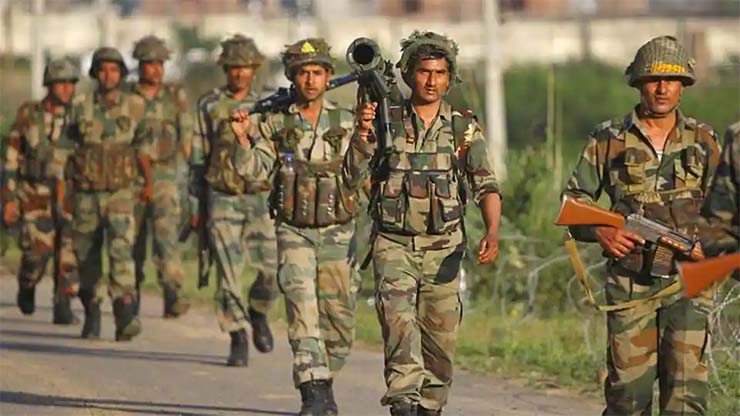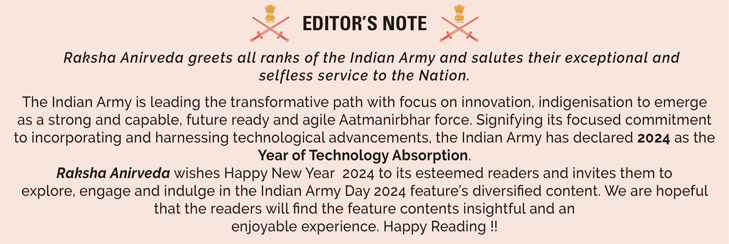
War and Warfare are fast outpacing the warfighter and his legacy tools. Contemporary wars have witnessed a tectonic shift in the goals of war, the rules of war, the players and the instruments of war, reshaping its character and placing increasing demands on warfighters. The debate is on – How do we know we are at war? Who is participating in the war? What rules govern war? Who is winning the war? How do we know the war has ended? In such a complex and ambiguous environment for the military to generate an integrated advantage, it will have to shed its erstwhile cloak and build on new ideas and evolve structures and redefine its modernisation needs. General Douglas MacArthur said, “New conditions require, for solution … new and imaginative methods. Wars are never won in the past.”
Future threats will manifest with multidomain character and grey zone preferences, aimed to embarrass and weaken the nation. Cyber, space, information, trade, society and finance have all become inseparable parts of future conflicts. As the war in Ukraine is reaffirming, nationalism, politics, society and people are the new players in this battlespace and the contest of will is as much about people as politics. Thus, deterrence has acquired an integrated construct of the whole-of-nation approach and conflict a whole-of-society approach. The mantra is Civil-Military Fusion in all spheres of defence capability building and warfighting.
There have been numerous discourses on Civil-Military Fusion in India. Despite reforms such as the appointment of CDS and the creation of the Department of Military Affairs, little progress has been made to overcome the siloed functioning and the trust deficit of “us versus them”. This has obviated integrated defence planning, long-term capability development and timely execution under one umbrella. At the apex level, the void of a national security strategy, the political impasse in the establishment of the Indian Defence University, the lack of cross-pollination and the absence of structural reforms in MoD are glaring examples of the state of affairs. Ironically, both the bureaucracy and the military are well-trained and experienced but hardly educated in matters of national security and even less integrated. Political guidance too must be rooted in a knowledge base effectively provided by a politician with a military background, or empowered by a permanent military commission within the MoD. All these remain on a wish list. Ironically, the threat matrix especially from China is escalating and the capability gap is asymmetrical.
Developing capabilities to counter China must be the primary focus, which would in turn cater to an irate Pakistan. The Chinese transgressions and the recent AIIMS Delhi ransomware attack cannot be seen in isolation. They display a strategic character and must not rest in the tactical domain. At the doctrinal level, the focus must shift from the contact battle to the operational and strategic domain both in the military and non-military segments. The nation cannot obfuscate the Chinese challenge and will have to exhibit greater foresight, resilience and urgency. The present contradictions of staying in strategic denial or allowing the burgeoning trade imbalance must shed its cloak and pave the way for a long-term integrated national response. China must be denied both physical and psychological ascendancy.
Incentives and investments
A strong military cannot be built on a paltry budget ending in repeated emergency panic procurements under crisis. It needs manufacturing prowess and homegrown technologies. Both these require incentives and investments. The lack of civil-military harmony and inter-ministerial disconnect has led to a lack of synergy in matters of defence capability building and morphed threat appreciation, and thus the nation reacts from crisis to crisis. Technologically we kept our modernisation focus to fight the last war with dwindling defence budgetary support and reforms, strategically we lacked a national security strategy and integrated vision, and operationally, military leadership was found wanting in the nuances of the operational art and joint warfare construct.
While the integrity of continental boundaries remains primary due to disputed borders, we need to look at capabilities beyond LC and LAC. Thus, the development of the maritime and aerospace domain merits due consideration. India must thus calibrate its military capability as a total of synergetic application of warfighting elements in all seven mediums – land, air, sea, space, underwater, cyber and cognitive domain. The need is to optimise tri-service capabilities beyond a single-service parochial approach based on an integrated military strategy to achieve desired political objectives. The present desirability and feasibility mismatch between the desired political objectives, suboptimal ways, and inadequate means must be resolved by interactive moderation and jointly constructed politico-military strategy. Since the development of the desired capability will take time, the temporal vulnerability must be offset by multilateral and bilateral deterrence albeit with due diligence to avoid any dependence.
Preemptive-proactive strategy
Doctrinally, the present reactive and defensive operational philosophy must transform into a preemptive and proactive strategy with deterrence based on denial. The determinant of its success will be information superiority and decision dominance supported by long-range standoff precision strike capability, dissuasive posturing and preemptive intent. The strategic construct of this strategy ‘to raise the cost of any military misadventure by our adversaries’ is more political than military. In short, we need a knowledge-based; decision-oriented, lethal networked joint force strike capability in both the kinetic and non-kinetic domains.
At the operational level, India’s military strategy entails managing threats on its disputed border by a ‘defensive holding psyche with attritionist force on force application’ rather than an ‘offensive domination and preemptive denial’ orientation. This has led to India’s conventional deterrence repeatedly being put to test in the recent past, leading to the exposure of strategic and operational voids, vulnerabilities and reactive response constructs. India’s force structuring philosophy has been essentially based on the traditional ‘Deterrence by Punishment and Threat cum Capability Approach’. The future restructuring philosophy will need to focus on a ‘capability-based approach with deterrence based on denial strategy’. Capabilities must optimise future technology exploitation in all domains and agile force structures must deny future threats by superior operational orientation. Further at the strategic and operational level, there is a need to comprehend the two basic concepts of ‘denial versus defence’ and ‘holding versus domination’. Denial seeks to make conflict/coercion look bad to the enemy, while defence seeks to make conflict/ coercion better for oneself by stalling the aggressor. Similarly, ground holding mindset brings in reactive ethos and predictability, whereas domination brings in aggressiveness and unpredictability. This is the essence and something the Indian establishment would do well to differentiate and review its conventional deterrence capabilities.
The capability development construct for making the military future ready must entail:
- Surface to Space Continuum. To achieve knowledge dominance, precision effects and operational speed, the military must graduate from their traditional two-dimensional spatial orientation to a vertical and cognitive integrated third-dimensional manoeuvre. The vertical component must include high altitude long-duration UAVs, Drones, UCAVs and airborne cum space satellite systems for ISR, SATCOM and PNT (positioning, navigation and targeting).
- Graduating from Jointness to Interdependence. The level of interoperability and complementarity between land, sea and aerospace must achieve the desired speed, economy and operational acceleration. The challenge lies more in silos mentality and service-centric mindsets. The Indian model of an “Integrated Joint Theatre Command” is indeed the destination but the path must be treaded first by strengthening desired capabilities and jointness of cultures.
- Modular and Scalable Force. Force application must be in an escalatory matrix by modular and scalable forces while in situ forces with inherent reserves provide the immediate preemption capability. These forces need to be technology-enabled, modular, scalable and tailor-made based on a mission-oriented grouping. They should combine a higher degree of agility, lethality, and survivability, yet be more rapidly deployable and intrinsically sustainable than the traditional force structure.
- Combined Arms Integrated Force Structure. The key to forcing a constitution must essentially be based on intrinsic combat, combat support and logistics elements including Attack Helicopters, UAVs, Air Defence, Artillery and C5ISR capability. However, their combat effectiveness would be a factor of rapid deployment ability, integrated training, interoperability, complementary capabilities, and the competence of commanders to synchronise their effect.
- Technology Empowerment. The mantra is quality over quantity and capability over capacity. In addition to technology induction, areas of C5ISR, Information Warfare, Cyber, Space and AI must find the requisite focus in our capability development empowered by a shift from a platform-centric approach culture to a network-centric approach.
- Empowered Leadership through Revitalised Professional Military Education (PME). The need is to evaluate the present PME effectiveness related to purpose; assess whether it is responsive to the dynamic military needs of the present and future, and appraise its development domains in their pursuit of professional excellence. The desired outcome of an effective PME must result in ‘creating and nurturing strategically minded intellectual warriors who demonstrate critical thinking, creative skills and technology adaption embedded in ethical military character to optimise joint force combat effectiveness in future battle space.’
To conclude, the starting point is to ruthlessly introspect, be honest, objective and dispassionate about present capabilities, structures, planning, processes and their limitations; candidly acknowledge the shortcomings as professionals; and then take pride in bridging the gaps. This would require integrity, moral courage, mutual trust and above all the will to prevail over the status quo. It would involve institutional fixing the cause and roots not symptoms as a hot patch. The challenges of fixated mindsets, institutional conservatism, military-political-bureaucratic harmony and budgetary penury will need to be addressed. The pace must be progressive and time-bound. Time may not be on our side.
-The author is a PVSM, AVSM, VSM has had an illustrious career spanning nearly four decades. A distinguished Armoured Corps officer, he has served in various prestigious staff and command appointments including Commander Independent Armoured Brigade, ADG PP, GOC Armoured Division and GOC Strike 1. The officer retired as DG Mechanised Forces in December 2017 during which he was the architect to initiate process for reintroduction of Light Tank and Chairman on the study on C5ISR for Indian Army. Subsequently he was Consultant MoD/OFB from 2018 to 2020. The Officer is a reputed defence analyst, a motivational speaker and prolific writer on matters of military, defence technology and national security.The views expressed are personal and do not necessarily carry the views of Raksha Anirveda











